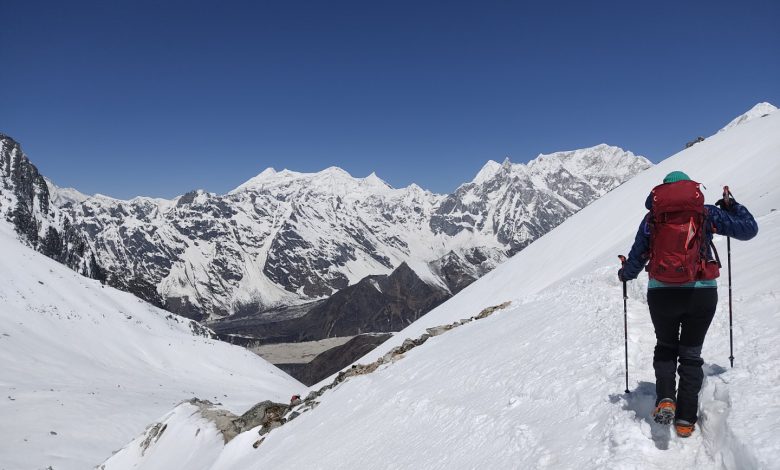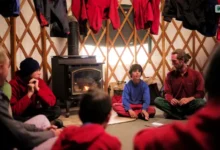Most challenging treks in Nepal

Nepal is a country renowned for its natural splendor, ancient history, and rich cultural heritage.
Nepal calls out to the adventurers from around the globe with its diverse landscapes and unparalleled trekking paths.
While iconic routes like the Everest Base Camp and Annapurna Base Camp draw heavy foot traffic, there are equally challenging and enchanting treks that gather less attention yet remain popular among intrepid explorers.
These treks are often considered the most demanding in Nepal.
These most challenging treks in Nepa offer unparalleled opportunities to push one’s limits and discover remote, rugged terrain.
Despite their lesser-known status, they boast breathtaking natural beauty and cultural encounters that rival those of more famous routes.
From the rugged trails of Kanchenjunga to the secluded wilderness of Makalu Base Camp, these journeys promise unforgettable experiences for those eager to test their trekking prowess and uncover the hidden treasures of Nepal’s majestic Himalayas.
Everest three passes trek
The Everest three Passes trek is one of the most thrilling adventures in Nepal in the Khumbu region.
It is challenging and exciting, taking you across three difficult passes: Kongma La (5,535m), Cho La (5,420m), and Renjo La (5,360m).
Starting from Lukla, you will follow the classic Everest base camp trekking trail before heading towards the Gokyo valley and then Everest Base Camp.
The hike from Tengboche (3860m) to Dingboche (4410m) to Kongma-La Pass (5535m) is tough, with Kongma-La Pass being the highest among the three.
The Cho-La pass (5420m) is the most challenging, starting near Lobuche Kharka and descending to Thangnak before continuing to Lobuche.
The Everest three passes trek takes about 20 days.
This trek isn’t suitable for beginners.
Crossing three passes above 5000 meters presents the main challenge, involving glaciers, unstable rock areas, steep ascents, and snow-covered paths.
However, those with good fitness and trekking experience can succeed and enjoy breathtaking panoramic mountain views, including Ama Dablam, Pumori, Cholatse, Khumbutse, Khalanga, Nuptse, and Lhotse.
The route passes through Sherpa communities, offering insight into their customs and culture.
You will encounter monuments, Buddhist monasteries, prayer wheels, and flags.
The Everest three passes trekking trail also passes through Sagarmatha National Park.
It showcases the Himalayan biodiversity with its unique flora and wildlife.
The extreme cold and high altitude are significant concerns.
Walking for about 5 hours daily, altitude sickness is a major risk, especially since most accommodations are above 4000m.
Trekking above 5000m can be harsh, requiring proper rest and acclimatization to avoid health issues.
Annapurna Three High Pass Trek
The Annapurna Three High Pass Trek is an exciting and challenging journey through the rugged terrain of the Annapurna region.
Lasting 24 days, this trek takes you through some of the most remote and breathtaking landscapes in the Himalayas. During the Annapurna three high pass trek you will conquer Namun Bhanjyang (5560m), Kang la pass (5306m), and Mesokanto la pass (5330m).
Annapurna Three High Pass Trek is considered the most challenging trek in the Annapurna region, it begins in Sikles and heads northward, passing through the Namun La pass and the remote villages of Phu and Nar.
After crossing the Kang La pass, you will reach the stunning Tilicho Lake before descending to Jomsom via the Mesokanto La pass.
This trek is physically demanding, with daily itineraries involving 5-6 hours of challenging uphill and downhill sections at high altitudes.
Altitude sickness is a significant risk, especially when crossing the mountain passes.
Experienced trekkers with a good track record in high-altitude environments and excellent physical condition are best suited for this trek.
Despite its challenges, the rewards are immense.
You will get the chance to immerse yourself in the rich cultures of the Gurung and Tibetan Buddhists, witness awe-inspiring views of the Annapurna, Manaslu, and Dhaulagiri mountains, and marvel at the beauty of Tilicho Lake, one of the highest lakes in the world.
Upper dolpo trek
The Upper Dolpo trek is a top choice for adventurous souls worldwide, offering an unparalleled journey through Nepal’s vast and remote landscapes.
It is located in Nepal’s largest and only trans-Himalayan national park, Shey Phoksundo.
The Upper Dolpo trek promises a challenging yet unique experience.
The main attractions include immersing oneself in the rich Bon and Buddhist cultures, encountering rare flora and fauna in the national park, and exploring the isolated Tibetan plateaus.
This trek demands long hours of hiking along paths less traveled, often described as off the beaten path.
Expect challenging uphill and downhill walks through rugged terrain, lasting up to 8 hours each day.
The Upper Dolpo region is isolated and untouched with civilization.
The less to no settlements adds to the Upper Dolpo trek’s difficulty.
Due to the lack of nearby settlements, trekkers must carry all necessities and set up tents for accommodation.
Spanning 27 days, the journey begins in Juphal and progresses to the stunning Phoksundo Lake.
From there, it moves to Yanjer Gompa in Upper Dolpo before circling back through the Dho Tarap valley and concluding in Dunai along the ancient Himalayan caravan trail.
The most challenging aspect involves crossing high passes such as Nagdalo La (5,350m/17,552ft) and Sela La Pass (5,100m/16,740ft).
Physical fitness is crucial for this trek as it is quite demanding.
While prior trekking experience isn’t essential, it certainly helps in tackling the challenges of the Upper Dolpo trek
Dhaulagiri Circuit Trek
The Dhaulagiri Circuit trek is an advanced and demanding adventure that takes you around the Dhaulagiri massif, home to Mount Dhaulagiri (8,1676 m), the seventh highest mountain globally, also known as the white mountain.
Lasting 20 days, the circuit begins from Darbang village, leading you through Dhaulagiri Base Camp and finally Mustang before reaching Pokhara.
The Dhaulagiri Circuit trek involves camping in remote areas and includes some technical sections.
The path is challenging, featuring rocky terrain, lateral moraines, glaciers, steep ascents, and long descents.
Expect to walk 6 to 7 hours daily on average.
This trek isn’t suitable for beginners.
Two high passes, the French Pass at 5360 meters and Dhampus Pass at 5,244m, pose significant challenges and test your endurance.
Proper preparation and acclimatization are crucial for easing the difficulties.
Despite its challenges, the Dhaulagiri Circuit Trek offers stunning rewards.
You will be treated to breathtaking, up-close views of Dhaulagiri, Annapurna, Dhampus peak, and Gurja Himal, alongside experiencing the charming lifestyle of Magar, Gurung, and Thakali communities.
Makalu Base Camp Trek
The Makalu Base Camp trek is a physically demanding adventure, unlike the more established routes in Nepal.
This longer, rugged, and intense journey offers an exhilarating trekking experience in the northeastern wilderness of the Makalu Barun National Park, leading towards the base of the 5th highest mountain in the world, Mount Makalu (8,485m).
Throughout the 24-day trek, you will need to cross three mountain passes, reaching a maximum altitude of 4,900m/16,076ft at Makalu Base Camp.
Expect to walk 5-6 hours a day on average.
The Makalu Base camp requires both physical fitness and mental readiness to tackle high-altitude and rugged terrains.
While previous trekking experience is beneficial, it’s not a requirement.
The trek rewards you with up-close panoramic views of towering mountains like Makalu, Lhotse, Kanchenjunga, Chamlang, Baruntse, and more.
Although the Makalu Base camp trek is challenging it is immensely rewarding as well.
You will have the chance to observe the unique flora and fauna of the national park, with the possibility of encountering rare species such as the Red Panda and Snow Leopard if luck is on your side.
Manaslu Circuit and Nar Phu Valley Trek
The Manaslu Circuit and Nar Phu Valley Trek are lesser-traveled and more challenging routes in the Nepalese Himalayas, combining the Manaslu circuit with the newer Nar Phu Valley trek.
This trek takes you away from modernization to the most remote areas along the Nepal-Tibet border.
The Manaslu Circuit trek and Nar Phu Valley trekking trails circle and branch out to the Annapurna and Manaslu regions, offering a unique perspective of the Himalayas.
Lasting 22 days, this trek takes you through high passes, rugged trails, and remote valleys.
It is both exciting and challenging, with daily walks averaging 7-8 hours.
Crossing two high passes, Kang La Pass (5320m/17,450ft) and Larkya La (5,165m/16,929ft), presents the most difficulty, requiring good physical fitness due to the high altitude.
Precautions must be taken to prevent altitude sickness, as most days are spent above 4000m, with some reaching 5000m.
You will have the opportunity to explore the remote Nar and Phu Villages, experience the unique Bon culture, and observe the rich Buddhist religion.
The trail offers stunning views of Manaslu, Tilicho Peak, Gangapurna, Nilgiri, and Annapurna, with fewer crowds.
Lucky trekkers may even spot rare snow leopards and Himalayan Thars in the Tibetan plateaus of the Manaslu Conservation Area.
Kanchenjunga Trek
The Kanchenjunga Trek is renowned as one of Nepal’s most demanding treks, lasting up to 28 days with daily hikes of 6-7 hours through rugged and steep landscapes.
The region boasts an isolated and rugged terrain, featuring dense forests, glacial rivers, and rocky paths, adding to the Kanchenjunga treks challenge.
There are two base camps, South Base Camp and North Base Camp, with three main variations to the trek.
The route typically begins from Taplejung, leading to either Kanchenjunga South Base Camp/Oktang viewpoint, North Base Camp/Pang Pema, or Kanchenjunga North to Makalu Trek along the Great Himalayan Trail.
Crossing three high mountain passes – Slele La (4,480m), Mirgin La (4,663m), and Sinon La (4,646m) – presents a challenging yet adventurous aspect of the Kanchenjunga trek.
Altitude sickness is a common concern, but proper acclimatization and precautionary measures can help mitigate the risk.
The main allure of the trail lies in trekking through the isolated and pristine Kanchenjunga Conservation Area, offering up-close views of the world’s third-highest mountain and showcasing its unique flora and fauna.

